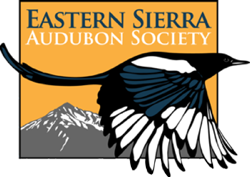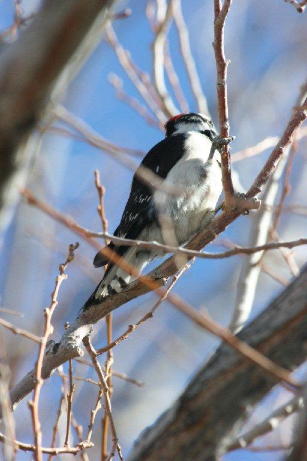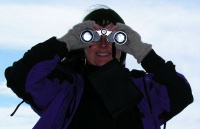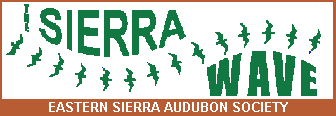
Eastern Sierra Audubon
Sierra Wave Newsletter
Volume 29, Number 3
January-February, 2011
Contents
- Events:
- Features:
- Reports:
- Conservation News:
- Business
Events
February Program: “Chicken Run” with Bob Steele
Note that the February Meeting will be held on Thursday, February 17th at the White Mountain Research Station (3000 E. Line St, Bishop). The date change was needed to accommodate speaker schedule.
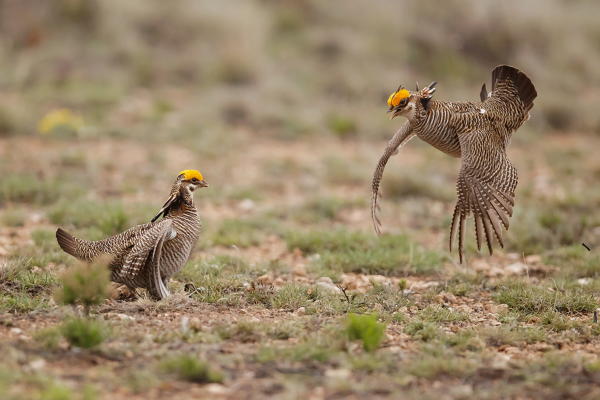
Lesser Prairie-Chickens, Photo ©Bob Steele (all rights reserved)
On Thursday, February 17th, join local professional bird photographer Bob Steele as we explore the wild “chickens” of North America. Grouse, Ptarmigan and Prairie-Chickens are an amazingly diverse and entertaining group of birds. Through photos, videos and stories we will look at unique breeding displays, and adaptations to habitats that vary from desert, to forest, to rocky mountains.
Bob’s photos can be seen in many publications: Birding, Wild Bird, Birder’s World, Ducks Unlimited, National Geographic Traveler, and National Wildlife magazines; books include: multiple National Geographic field guides, the Smithsonian Field Guide to Birds of North America, American Museum of Natural History Birds of North America, and the recently published Stokes Field Guide to Birds of North America. Bob’s work is featured at: www.bobsteelephoto.com
NOTE the change in day/date for an ESAS program. For more information call Roberta at 760-872-7846. Everyone is welcome to attend!
Back to Top
Upcoming Field Trips
Round Valley and Millpond Birding, Saturday, January 15
Now in the very dead of winter some species are preparing to nest. We’ll walk a mile or two along country roads in Round Valley, an especially good locale for raptors. Participants may then drive a few miles south to bird Millpond, a recreation area northwest of Bishop. Scenery guaranteed! Bring warm clothes, water, snacks, binoculars. Trip will end by noon. Meet leader Larry Nahm at 8:30 a.m. just west of the junction of U.S. 395 and Pine Creek Road, about twelve miles north of Bishop. Call 872-4125 for more information.
Big Pine Winter Wildlife Tour, Saturday February 26
Experts Tom and Jo Heindel annually lead a popular auto excursion between Klondike Lake and Tinemaha Reservoir. Mountain Bluebirds, Bald Eagles, bobcat, elk, owls, creepers, mergansers, sparrows and swans – these are examples of species which have turned up on past tours. Meet at 8:00 a.m. at Glacier View Campground off U.S. 395 just north of Big Pine. Bring water, snacks, binoculars, scopes. The outing should end mid-day. For more information please call the leaders at 938-2764.
Back to Top
Save the Date! Great Backyard Bird Count
Eastern Sierra Audubon is excited to announce we will be participating in the Great Backyard Bird Count in 2011.
The 2011 GBBC will take place Friday, February 18, through Monday, February 21.
The Great Backyard Bird Count is an annual four-day event that engages bird watchers of all ages in counting birds to create a real-time snapshot of where the birds are across the continent. Anyone can participate, from beginning bird watchers to experts. It takes as little as 15 minutes on one day, or you can count for as long as you like each day of the event. It’s free, fun, and easy—and it helps the birds.
Please visit The Great Backyard Birdcount website for more information, and stay tuned as we announce more information in February.
Back to Top
Articles
President’s Message
“If you take care of the moment, you take care of all time”
— The Dalai Lama
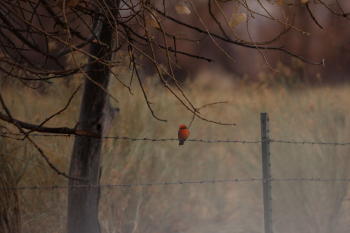
Vermillion Flycatcher, Photo by Steve Brad
The report from the Christmas Bird Count of a Vermillion Flycatcher sighting brought me much pleasure. This is one of my favorite birds. It jumps from the landscape with its striking color. My fist Vermillion was a vagrant which had
found its way to a vineyard in Lodi one January. Wandering outside an industrial
fence in the fog we finally located a bright red dot and were able to focus on
the bird itself. How it shone against the gray backgrounds of a central valley
winter! A couple of years ago, we followed one around the hiking area behind
the Living Desert botanical gardens in Palm Desert. The bird moved twenty or thirty yards at a time and then displayed, guiding us through the area and leading
to sightings of other species.
Non-bird people often ask me “what is the deal with looking for birds and memorizing all the names?” The looking part is easy. Birds are outside; they are amazing (they can fly); they are beautiful and do interesting things. For a long time, I had no answer for the part about learning the names. My argument was that it was sufficient to bear witness to the beauty and variety of what I was seeing. I am sure that this was a way to get around my concern that the effort to know what all these things are was just too daunting.
Jack Laws says that the naming of things was a process that allowed early man to exercise some sense of mastery over his surroundings. If you saw something and identified it with a name it was easier and quicker to determine if it was
dangerous. This would allow people to move more efficiently and safely through the world without having to stop at every turn to see how something would act.
This concept has insinuated itself into my thinking as I have slowly began to recognize specific birds and put a name to them. To me, this is a way to pierce the mysterious and make sense of the myriad sounds, calls, shapes, colors and sizes that populate the world. Slowly, the landscape becomes familiar and vaguely understandable. Comfort comes from the return of the Juncos in the winter, the Yellow-headed Blackbirds in the spring or the Pelicans in the fall. I worry when these birds are “too early” or “too late” because I want their appearances to mean that my life is ordered.
At the same time, every trip into the field brings the possibility of encountering the unexpected. There is always the chance of finding something wildly out of place in the most familiar of settings. Questions abound: how did it get here; from where; how long will it stay; has there been one before and, if so, when…how often? So it is with anything. If you slow down, you see more. As you see more, you realize how much remains unknown. I am perplexed by people who are unable or unwilling to acknowledge and respond to the mysteries in the world around them. Some folks act as though curiosity is a vice and that it is important to believe you know everything necessary. This seems sadly limiting.
The spirit of the bird count is uplifting and infecting. Go see what there is to see. How does this compare with what was seen before? What do these differences mean? This is a great perspective to take into a new year. What will I find in the coming months, what will literally stop me in my tracks and make me think. and what will I be called to do? May we all find exciting and rewarding additions to our life lists, what ever those lists might be.
Pete Pumphrey
Back to Top
Feature: A Record Year
2010 Fall Fallout in Inyo County
Click on any of the photos for a larger version
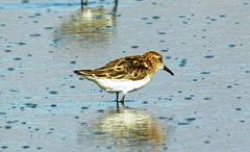
Little Stint, photo by Jon Dunn
Some Falls can be a little slow and others can be exciting but sometimes a flood of rare species arrive inundating the record books. This season accumulated a list of highlights so lengthy that this article will only deal with the crème de la crème.
The two rarest avian visitors to Inyo County are so rare in California that the sightings must undergo review by the California Bird Records Committee to determine if there is enough evidence to convince a large majority of members that the observer(s) couldn’t be wrong. Photographs or images can make the Committee’s discussion fairly short and while both species were difficult birds to photograph, identifiable record shots were taken. An adult Little Stint was found at Owens Lake on 6 August by JLD*[photographers listed at end of article]. This is the second record for Inyo County; the first was found at Owens Lake on 29 August 2009 by CBH and JLD. This species breeds from Scandinavia to Siberia and most birds winter in southern Europe, Africa, the Middle East, and the Indian subcontinent with a few reaching Southeast Asia. Lost birds have been recorded to North Dakota and New Mexico! There are eleven State records with adults found primarily July to August and first-fall birds from September to November (Rare Birds of California 2007). This species is difficult to identify and the fact that the Committee has not accepted more sightings than it has accepted attests to that. All accepted records were photographed except one and that was validated by a specimen.
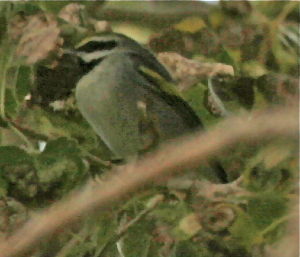
Golden-winged Warbler, Photo by Jo Heindel
An immature male Golden-winged Warbler was found at Diaz Lake 23 Oct by KHL and JAH and it was seen and photographed there the following day. This is the eighth County record ending a three decade drought since the previous seven birds were recorded between 1974-1979! This species breeds from southern Manitoba and northern Minnesota east and south to western North Carolina. Most birds winter from southern Mexico to northern South America along the Atlantic slope with strays recorded west to WA, OR, and Baja CA, south to Ecuador, and east to Great Britain (Rare Birds of California 2007). There are 72 State records with 51.5% in fall, 41.5% in spring, and 7% in winter. Inyo County’s records are evenly distributed with four in spring and four in fall.

Sprague’s Pipit, Photo by Chris Howard
A Sprague’s Pipit was photographed at Stovepipe Wells 2 Oct (CBH, RCH) for the 5th County record with all occurring in October. Two Western Gulls were seen and photographed at Owens Lake 17 Nov (RJS, SLS) representing the 6th County record. The previous five records were during this last decade, 2000-2009 with three in fall (late Aug-late Oct) and two in spring (late Mar-late May). Adults have been recorded primarily in spring and early fall while immatures usually occur in Sep and Oct. An immature male Canada Warbler was photographed at Birchim Canyon 22-23 Sep (JRP, DAP, SKB, CBH, RCH) for the 7th County record, all evenly distributed in spring (late May-mid Jun) and fall (early-late Sep). Stilt Sandpiper was recorded at Owens Lake 21 Aug (JLD, RJS, SLS, CBH, RCH) and 29 Aug (RJS, SLS); it is problematic if it was the same individual. There are eight previous records for County with all found in the Owens Valley except the two recorded at Furnace Creek Ranch; only two records occurred in spring (late May) whereas there are seven in fall (late Aug to mid Sep). A Scarlet Tanager was photographed at Birchim Canyon on 25 October (JRP, DAP), which is the tenth County record and the seventh in fall (mid Oct-mid Nov).

Red Knot on Owens Lake. Photo ©Bob Steele (all rights reserved)
A Red Knot was seen and photographed at Owens Lake on 19 Sep (RJS, SLS) for the 11th County record with nine records occurring in fall (late Aug-late Oct). A Kentucky Warbler was photographed in Deep Springs Valley 12 October (RJS, SLS, NJO) also for the 11th County record but only the second record in fall. Three juvenile Ruddy Turnstones were photographed at Owens Lake 21 Aug (RJS, SLS, SKB, CBH, RCH) for the 14th County record, all but four records occurring in fall (late Jul-late Sep). An immature female Eurasian Wigeon, photographed at Bishop City Park 27 Nov through 15 Dec (JLD, DVP, JRP, DAP, LH, TSH, JAH), is the 20th County record with a time span from mid Oct to mid May. An Eastern Phoebe was photographed at Diaz Lake 27 Oct (TSH) for the 22nd County record; all birds have been found from mid Oct to late May. An immature female Orchard Oriole was photographed at China Ranch 11 Sep (CGL, CBH, RCH) for the 27th County record with 17 occurring in fall (mid Aug-mid Nov). Two female Purple Martins were recorded at Owens Lake 17 Sep (REM) for the 29th County record, which are evenly distributed in spring (mid Apr to early Jun) and fall (early Aug to late Sep with an outlier in late Oct).
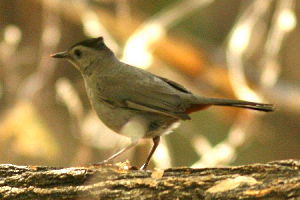
Gray Catbird, Photo by Debby Parker
Take a deep breath…the list of the best of the best continues: Gray Catbird (38th County record), Grasshopper Sparrow (47th), Ovenbird (49th), Prothonotary Warbler (50th), Pacific Loon (53rd), Surf Scoter (60th), Band-tailed Pigeon (69th), Palm Warbler (72nd), Lawrence’s Goldfinch (77th), Williamson’s Sapsucker (90th), and Ruddy Ground-Dove (100+).
Other species, not particularly rare during their normally occurring seasons, set records by lingering longer than ever before. Two Lesser Yellowlegs, photographed at Owens Lake 13 Nov (KHL) with one bird recorded there 14 Nov (SLS) were the latest ever by three weeks. An immature male Calliope Hummingbird was photographed at Big Pine 14-16 Oct (TSH, JAH), which extended the latest ever date by ten days. A lingering Dusky Flycatcher was photographed at Birchim Canyon 1-29 Nov (JRP, DAP, RJS, SLS, JLD, DVP, LH) moving the latest date by fifty days! The Ovenbird photographed in Birchim Canyon 11-28 Nov (RJS, SLS, JRP, DAP, NJO, CBH, RCH, WHM, DJH) extended the late date by twenty-four days. An adult male Bullock’s Oriole, photographed at Diaz Lake 24 Oct (CBH), was much later than the average departure dates in mid Sep; there are only three later records: 28 Oct, 4 & 20 Dec. Early Bald Eagles usually appear in the County in mid Oct but one was reported at Lake Sabrina 5 Sep (ADK) to set an earliest ever record.
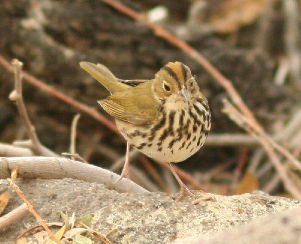
Ovenbird, Birchim Creek, Photo by Debby Parker
Two rare subspecies were recorded: The “zaboria” Red Fox Sparrow was photographed at Birch Creek 26 Nov (J&RG) and the “pink-sided” form of Dark-eyed Junco was noted at Aspendell 30-31 Oct (RJS, SLS). Irruptive species from the mountains, either nearby or northerly, found the lowlands more comfortable and there were numerous reports of Mountain Chickadees, Brown Creepers, and Golden-crowned Kinglets from Birchim Canyon and Bishop.
Lastly is the immature male American Redstart photographed at Birchim Canyon 17-18 Sep (DAP). This sighting has significance in an historical context. The first record for the County is in 1957 and from then through 1969 there were 44 additional records with many of 4-6 birds at one location on one day by one party. During the 1970s there were 122 records added with most records of 1-2 birds, many of 3-4 birds, and single records of 9 & 10 birds both found at Deep Springs College ON ONE DAY by one party! During the 1980s, when coverage took a big dip, there were 44 records added with most reports of single birds, a few of 2-4, and a single high count of 7 birds at Deep Springs College. During the 1990s, when coverage began to increase, there were 77 records added with almost all reports of single birds, a few of two, and a single record of three birds at Deep Springs College. During the 2000s, through 2009, there were 46 records added with all of single birds except one record of 2 birds. Fall reports over the years average 3.3 birds/yr and 2.9 birds/yr in spring but the steady decline since the 1970s has turned this bird from a “ho-hum, is that our 4th or 5th today” to a “WOW” species. Nationwide trends are complex with variations during different time periods and different geographic regions but on a continental scale the population has declined, primarily due to man-caused loss of riparian habitat. This acrobatic dancer and flashy dresser is an unforgettable experience as was Fall 2010 in Inyo County to all those who enjoyed the ride.

Kentucky Warbler, Photo ©Bob Steele (all rights reserved)
Even with a cursory look at the list, a reader quickly becomes aware that almost all of the County records are substantiated with photographs. The few without are supported with convincingly written documentation. Again, our gratitude to those initialed above for the energy, physical and mental, and the aggressive caution they apply to field ornithology. (Alphabetized by first letter) ADK-Andrew Kirk, CBH-Chris Howard, CGL-Carl Lundblad, DAP-Debby Parker, DJH-Debbie House, DVP-David Vander Pluym, JAH-Jo Heindel, JLD-Jon Dunn, J&RG-John & Ros Gorham, JRP-Jim Parker, KHL-Kelli Levinson, LH-Lauren Harter, NJO-Nancy Overholtz, RCH-Rosie Howard, REM-Bob Maurer, Jr., RJS-Bob Steele, SKB-Steve Brad, SLS-Susan Steele, TSH-Tom Heindel, and WHM-Bill Mitchel. Others who supplied further records for this season and not cited individually above and to whom we are equally indebted are: Jan Bowers, Brian Daniels, Kathy Duvall, Tom Edell, Carolyn Gann, Giar-Ann Kung, Steve McLaughlin, Don Roberts, Connie Spenger, and Len Warren.
Tom & Jo Heindel
Back to Top
Bird Identification Challenge
Know your field marks!
This bird was photographed in Bishop in February of 2008.
When you can’t see the more “obvious” field marks, you need to know what else to look for. If you are ready, try to ID it before reading the hints or checking the answer.
Do you need a hint? Here are three:
Hint 1 (click here to show hint)
You probably know it’s a woodpecker, but what kind? Nuttall’s Woodpeckers have black and white barring on the back and dark markings on the underside. The woodpecker in the photo has a pure white underside and subtle white wing markings.
Do you have a guess?
Hint 2 (click here to show hint)
Although you can’t see the obvious field mark of a long white patch on its black back, the pure white underside tells you it’s either a Hairy Woodpecker or a Downy Woodpecker.
Can you tell which?
Hint 3 (click here to show hint)
You usually use the bill size to tell the two apart, but the bill is not showing! Then you remember... “Downy Does, Hairy Hasn’t.”
Ready to ID the bird now?
From Debby Parker
Back to Top
Reports
The 29th Annual Bishop Christmas Bird Count Results
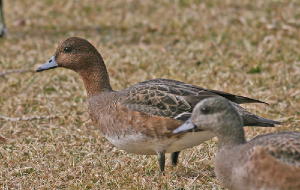
Eurasian Wigeon, Photo by Tom & Jo Heindel
The 2010 Bishop Christmas Bird Count was held on Saturday, December
18th. Forty-four hardy birders divided into thirteen teams and
battled persistent drizzle and temperatures in the upper 30’s to lower
40’s F. Despite the cold and damp conditions, birds were found in
respectable numbers and diversity. The total species count
is 102, representing many expected species and some rarities. The
tally countdown potluck was again hosted by the ever-generous James
and Kay Wilson.
Many thanks to the dedicated and careful birders who make the Bishop CBC such a well-respected and fun scientific event. Thanks also to
the Mono County birders who wanted to attend the Bishop CBC but were
turned around by snow.
At this time, substantiated rarities (many with excellent photos)
include:
- three swans (presumed Tundra) flying over north Bishop,
- a
continuing female Eurasian Wigeon at the Bishop City Park,
- a
breeding-plumaged Common Loon at the Bishop Sewer Ponds,
- a Western Grebe at Nik and Nik gravel ponds,
- at least one and perhaps two Rough-legged Hawks north of Bishop,
- four Greater Yellowlegs (2 in
Round Valley, 2 at the Bishop Sewer Ponds),
- two Least Sandpipers at
the Bishop Sewer Ponds,
- an adult male Anna’s Hummingbird frequenting a
Shepard Lane feeder,
- an exceptionally late Dusky Flycatcher which
appears to be attempting to winter in Birchim Canyon,
- an adult male Vermillion Flycatcher in the fields west of downtown Bishop,
- a flock of
8 Western Bluebirds at the fairgrounds,
- a Chipping Sparrow at
Millpond, an immature Harris’s Sparrow in Round Valley,
- and two Evening Grosbeaks in south-east Bishop residential.
- [editor’s note: “...and a partridge in a pear treeee!” - sorry - it had to be done.]
Notable misses on count day were Snow, Ross’s, and Cackling Geese,
Northern Pintail, Redhead, Common Merganser, Chukar, Virginia Rail,
Greater Roadrunner, Western Scrub-Jay, Clark’s Nutcracker, Canyon
Wren, Townsend’s Solitaire, Vesper Sparrow, Western Meadowlark, and
Great-tailed Grackle. Count week birds (seen during the week of the bird count but not on count day) found so far are
Golden-crowned Sparrow and Pink-sided Junco.
Chris Howard
Bishop CBC Compiler
Back to Top
Mike Prather Honored by Whitman College
Whitman College, a small liberal arts school located in Walla Walla, Washington, offers a program for students called Semester in the West.
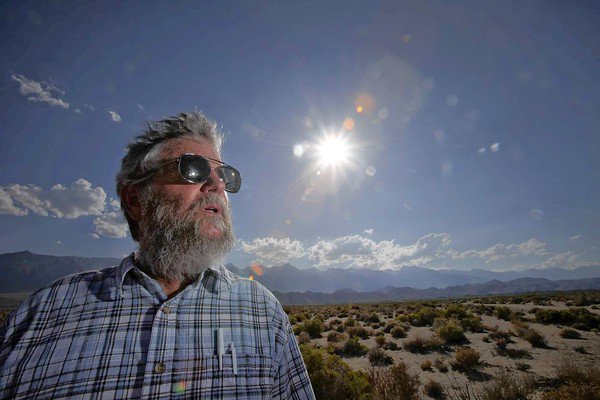
Mike Prather
Semester in the West is an interdisciplinary field program in environmental studies, focusing on public lands conservation in the West. The objective is to come to know the West in its many dimensions, including its diverse ecosystems, its social and political communities, and the many ways these ecosystems and communities find their expression in regional environmental writing and public policy. Every other autumn since 2002, a group of Whitman College students ventures out into the interior West for field meetings with a wide variety of leading figures in conservation, ecology, environmental writing, and social justice. During the course of the semester, they typically have the opportunity to visit with sixty or seventy such leaders.
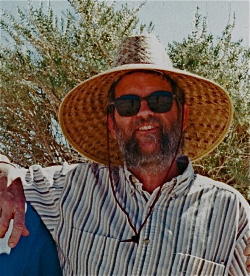
Mike Prather: Plovinator
The goal is to explore the complexity of environmental issues in the West, while at the same time locating pathways toward meaningful individual and collective action to conserve and enhance the West’s natural and human communities.
Unknown to many of us, Mike has been meeting with the student groups since 2004. In the words of the program director, Mike is “quite simply the perfect person to put in front of students. He is not only a fine educator about Owens Valley and Owens Lake, but also a great example of environmental citizenship.” Whitman College made a donation to Eastern Sierra Audubon Society to honor the work of Mike. Thank you Mike!
Some of the students, Mary Patzel and Matthew Morriss, were inspired by Mike to do their final projects on Owens Lake. Those projects are on the website: www.semesterinthewest.org. They can then be found by going to the link “Podcasts 2010.”
[Ed. Note: These are great - definitely take the time to listen. The two with Mike in them are in the bottom two rows - Morris and Patzel - click on their photos to listen online, or the links to download.]
Reported by Bill Mitchel
Back to Top
Shoshone Trails Open
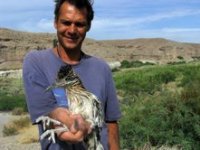
Len Warren at Shoshone
Hello Birders, I would like to invite you all to try the new Shoshone Village
self guided birding trails.
There are three trails. The Blue Trail begins at Crowbar Restaurant
and takes you into the Amargosa River riparian zone, dominated by
Honey Mesquite. The Red Trail does the same beginning at the
campground at the north end of town. The Aqua trail takes you on a short
walk through a scarce (around here) wet meadow, created by the
Shoshone Spring swimming pool.The trails are clearly marked with 6
foot wooden poles painted to the color of the trail. You can see from
pole to pole throughout the trail. All conscientious birders are
welcome to enjoy this private nature preserve. Our winter specialties
are Crissal Thrasher, Black Tailed Gnatcatcher, and there is a year-round
Cactus Wren, too.
We have great lodging, and camping. I would be happy
to give a tour to any birders almost any time. I am available most
anytime after Christmas till March 1st. You can find me at
birdman88.com@gmail.com or you can leave a message at 760-852-1001. Hope to see you soon!
Len Warren,
Shoshone Village
More information about Shoshone-Tecopa Important Bird Area (pdf). Also be sure to check out Len’s Shoshone Village bird blog, Birds of Shoshone Wetlands, for great photos and updates.
Back to Top
Field Trip Report: Pleasant Valley Reservoir, November 27
A lingering Osprey and two hard-to-spot female Hooded Mergansers highlighted a morning’s shoreline walk. Colorful feathers of several Wilson’s Snipe also gave us pause. The nine participants recorded the expected wintering Green-winged Teal, Ruddy Ducks, Ring-necked Ducks, Common Mergansers and Cormorants. Birding an inlet stream after recording nearly thirty species, most of us looked for a very rare Ovenbird seen three days earlier. Our luck had run out, but memories of a fine raw morn may linger.
Larry Nahm, Trip Leader
Back to Top
Conservation News
Owens Lake Update
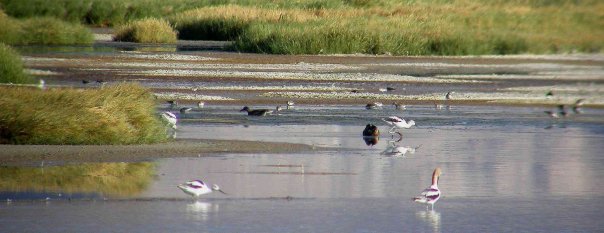
Sulfate Well habitat providing food and shelter for avocets, sandpipers and ducks, Photo by Mike Prather
The Owens Lake planning process continues through the holidays and into the new year. More than thirty five organizations have worked since February 2010 to draw up a “master plan” for future activities at the lakebed. This process is an outgrowth of the ESAS/Audubon California initiated “conservation action plan” process which began in the spring of 2008. Mike Prather and Pete Pumphrey have participated on behalf of Eastern Sierra Audubon and Andrea Jones on behalf of California Audubon. I am pleased to report that the atmosphere which surrounds this process has been very positive and the many groups, agencies, interests and stakeholders have been committed positive and consistently respectful.
The larger planning group has met seven times with the next meeting set in January 2011. The project area has been designated as the historic lakebed which is some 110 square miles in size. An outline for the plan contents has been developed and drafts of individual sections are beginning to appear. Working groups were established to address issues in the areas of habitat designation and management, renewable energy, dust control, public access and recreation, native cultural values, grazing and mining, and plan implementation and process governance. The reports of these groups will provide the basis for the detailed contents of the plan.
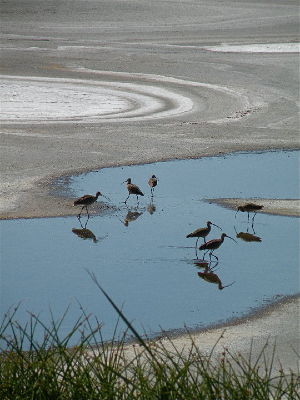
Long-billed Curlews at Owens Lake
Photo by Mike Prather
Of particular concern to Audubon is the objective of creating a permanently protected habitat area to support the many, many birds which have returned to the lake as a result of the reintroduction of water as a means of dust control.
Developing recommendations for this goal has been a long and complicated journey. The habitat group has met some six or seven times and countless hours haven been spent creating and refining tools to identify and measure habitat values in the project area. Additional meetings are set for January and into the new year. Integrating the habitat values into an emerging suite of dust control technologies and concerns has been a challenging task.
It is hoped that a first draft of the document will be ready in March or April of 2011 and that the CEQA process for its review will begin shortly thereafter. The California State Lands Commission will be the lead agency for this review. There is a website (Owens Lakebed) which has copies of draft documents which will be updated as the process continues. If you have any questions, comments or concerns, please pass these along to Mike or Pete and watch for new developments.
Pete Pumphrey
Back to Top
Help Needed in Mapping Raptor Nests
If you know the locations of raptor nests (excluding ravens), the BLM
would like to have the data. The BLM District Office is putting together a
GIS layer to help site wind farms. There are several wind farm companies
that are putting up meteorological towers and may apply for wind farm
rights of ways in the future. They are worried about golden eagles and other
raptors that may have nests or foraging areas in the areas where wind
turbines might be installed. For more information, or to
help collect data by reporting nest locations, contact BLM Wildlife Biologist, Shelley Ellis at 760-384-5426 or ssellis@blm.gov.
Back to Top
Taking Care of Business
Reminder - Bishop Sewer Ponds
As most of you know, the Bishop Sewer Ponds is one of our local birding hot spots.
We’d like to remind everyone that the Bishop Sewer Ponds are accessible by advance permission only.
This has been the agreement for many years. Recently, City of
Bishop staff said they have observed birders that have not obtained
permission on multiple occasions. They also said if this continues,
it could “jeopardize access” for birders.
We are fortunate to have developed a positive relationship with the
City of Bishop and gained the ability to bird beyond the “No
Trespassing” signs. The phone number to call is 760-784-1417.
Good birding,
Chris Howard
Back to Top
How You Can Help ESAS: Four R’s
Renew your membership (or join)! The money from your membership dues is what helps us bring great evening programs, special events, educational programs, trips, this website, and more to the community - we need your support!
Recycle at Manor Market and tell them to donate the money to Eastern Sierra Audubon.
Respect property and get permission to bird on private or restricted access property (such as the Bishop Sewer Ponds - see above)
Repeat! Spread the word about programs and events, encourage others to join and participate.
Message from the Editor
Working on the newsletter on this very rainy day after the Christmas Bird Count makes me appreciate the “good” weather we did have on CBC day this year. The rain was fairly light, not pouring like it is today, and there was no wind - how lucky! This was my very first Christmas Bird Count. I would like to thank the wonderful people of Eastern Sierra Audubon, especially Chris Howard, who organizes it every year, for making me feel welcome to participate. In the past, I’ve never felt I was a good enough birder to take part in any counts, but Chris and everyone else made it clear that even beginners were welcome, as they’d be grouped with more experienced birders, which made it much less intimidating. Turns out, it wasn’t intimidating at all - just a lot of fun! Even in the cold, rainy weather (or maybe, partially because of it).
I asked the group at the potluck afterward if I could now be considered a hard-core birder after spending 7 hours birding in the rain. They agreed - I’m in!! Seriously, though, I’m not. I’ve always been an opportunistic birder... but the people in ESAS are so great, they make me want to be a better birder!
Please Contribute!
All of our great content is supplied by our amazing members... and speaking of that, if you have any ideas about articles you’d like to see, or better yet, if you have anything to share for newsletter publication, whether an article, a news item, update, correction, poem, essay, artwork, photo, field trip report, neat birding experience, letter, etc, please send it, along with any comments or suggestions, to maggiewolfe@gmail.com. We’d love to hear from you!
You may send items for inclusion in the newsletter at any time, but please send any timely items to arrive before the first of the month, so they can be included in the monthly email update. The next official newsletter will be March/April 2011, so send submissions to arrive by the last week in February at the latest. We will try to send out email updates on the first of every month to include any reminders or timely articles for that month.
Thanks for reading, and happy birding!
Maggie Wolfe Riley, Newsletter Editor
Back to Top
About Eastern Sierra Audubon
Current Board Members
Membership
Main Calendar of Events
ESAS Events in January and February
Back to Top
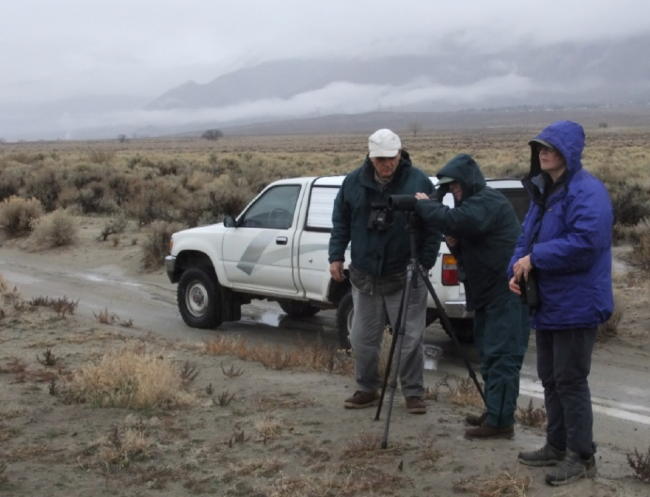
Tom and Jo Heindel and Barb Kelley discuss a distant eagle during our wet CBC - Photo by Dave Pederson
Bird Quiz Answer:
The bird is a Downy Woodpecker. The important field marks in the photo are the black bars on the outer white tailfeathers.
